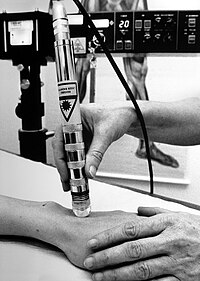
Hair Regrowth Outcomes of Contact Immunotherapy for Patients With Alopecia Areata: A Systematic Review and Meta-analysis
Sign Up to like & getrecommendations! Published in 2018 at "JAMA Dermatology"
DOI: 10.1001/jamadermatol.2018.2312
Abstract: Importance Contact immunotherapy with diphenylcyclopropenone or squaric acid dibutyl ester is a preferred treatment for severe alopecia areata; however, the defined criteria for therapeutic hair regrowth and regrowth rate have been highly heterogeneous across studies.… read more here.
Keywords: regrowth; alopecia areata; contact immunotherapy; hair regrowth ... See more keywords

Time-Dependent Risk of Acute Myocardial Infarction in Patients With Alopecia Areata in Korea.
Sign Up to like & getrecommendations! Published in 2020 at "JAMA dermatology"
DOI: 10.1001/jamadermatol.2020.1133
Abstract: Importance Alopecia areata (AA) is a common autoimmune disease presenting as nonscarring hair loss. Although AA can be associated with other autoimmune comorbidities or atopic diseases, little is known about the risk of cardiovascular diseases… read more here.
Keywords: alopecia areata; risk; risk acute; myocardial infarction ... See more keywords

Familial implications of autoimmune disease: Recurrence risks of alopecia areata and associated conditions in first‐degree relatives
Sign Up to like & getrecommendations! Published in 2019 at "Journal of Genetic Counseling"
DOI: 10.1002/jgc4.1178
Abstract: Alopecia areata (AA), a complex autoimmune hair loss condition, affects approximately 2.1% of the population. Individuals with AA have increased susceptibility to diseases such as atopy and autoimmune disorders, but little is known about first‐degree… read more here.
Keywords: degree relatives; alopecia areata; associated conditions; first degree ... See more keywords

The Use of a 1,540 nm Fractional Erbium‐Glass Laser in Treatment of Alopecia Areata
Sign Up to like & getrecommendations! Published in 2019 at "Lasers in Surgery and Medicine"
DOI: 10.1002/lsm.23133
Abstract: Varieties of laser and light sources have been tried for treatment of alopecia areata (AA) and some success has been reported. To assess the effectiveness of 1,540 nm fractional erbium‐glass laser in treatment of AA. read more here.
Keywords: fractional erbium; alopecia areata; treatment alopecia; treatment ... See more keywords

Efficacy and Influence Factors of 308‐nm Excimer Lamp with Minoxidil in the Treatment of Alopecia Areata
Sign Up to like & getrecommendations! Published in 2020 at "Lasers in Surgery and Medicine"
DOI: 10.1002/lsm.23210
Abstract: Alopecia areata (AA) is an autoimmune disease characterized by T cell‐mediated attack on the hair follicle. Although there are a wide range of therapies, the majority of them are not satisfactory due to side effects… read more here.
Keywords: alopecia areata; efficacy influence; efficacy; influence factors ... See more keywords

Comparison of the efficacy and safety of 308-nm excimer laser with intralesional corticosteroids for the treatment of alopecia areata: A randomized controlled study.
Sign Up to like & getrecommendations! Published in 2021 at "Lasers in surgery and medicine"
DOI: 10.1002/lsm.23501
Abstract: BACKGROUND Corticosteroids have been the mainstay of treatment for alopecia areata (AA). Recently, the 308-nm excimer laser has been proposed for treating AA. OBJECTIVES To compare the efficacy and safety of excimer laser with intralesional… read more here.
Keywords: excimer laser; alopecia areata; treatment alopecia; laser ... See more keywords

Patients with alopecia areata show signs of insulin resistance
Sign Up to like & getrecommendations! Published in 2019 at "Archives of Dermatological Research"
DOI: 10.1007/s00403-019-01929-6
Abstract: Alopecia areata (AA) is an autoimmune disease associated with high levels of proinflammatory cytokines. Since chronic inflammation plays a major role in the pathogenesis of insulin resistance, AA can theoretically increase the risk of diabetes.… read more here.
Keywords: median iqr; alopecia areata; patients alopecia; resistance ... See more keywords

Comparative study for treatment of alopecia areata using carboxy therapy, intralesional corticosteroids, and a combination of both
Sign Up to like & getrecommendations! Published in 2021 at "Archives of Dermatological Research"
DOI: 10.1007/s00403-021-02201-6
Abstract: Alopecia Areata (AA) is a common autoimmune disease, with an unpredictable course and no standard treatment with guaranteed outcome. Intralesional corticosteroids is the most commonly used treatment for patchy AA, but with a common side… read more here.
Keywords: alopecia areata; treatment; intralesional corticosteroids; carboxy therapy ... See more keywords

New and Emerging Therapies for Alopecia Areata
Sign Up to like & getrecommendations! Published in 2020 at "Drugs"
DOI: 10.1007/s40265-020-01293-0
Abstract: Alopecia areata (AA) is an autoimmune condition that affects up to 2% of the general population. Currently available treatment options for AA are of limited efficacy and can be associated with adverse effects. The advancement… read more here.
Keywords: emerging therapies; new emerging; alopecia areata; therapies alopecia ... See more keywords

The majority of patients presenting with vitiligo have a clinical sign of activity
Sign Up to like & getrecommendations! Published in 2017 at "Journal of the American Academy of Dermatology"
DOI: 10.1016/j.jaad.2017.05.027
Abstract: REFERENCES 1. Xing L, Dai Z, Jabbari A, et al. Alopecia areata is driven by cytotoxic T lymphocytes and is reversed by JAK inhibition. Nat Med. 2014;20:1043-1049. 2. Liu LY, Craiglow B, Dai F, King… read more here.
Keywords: majority patients; alopecia areata; presenting vitiligo; clinical sign ... See more keywords

Vitamin D deficiency in patients with alopecia areata: A systematic review and meta‐analysis
Sign Up to like & getrecommendations! Published in 2018 at "Journal of the American Academy of Dermatology"
DOI: 10.1016/j.jaad.2017.07.051
Abstract: on diphenylcyclopropenone (DPCP) maintenance treatment (MT), we first compared the treatment interval of patients who a had relapse with those who did not. Because there was a significant difference in Intervalmnt itself (P 1⁄4 .022),… read more here.
Keywords: deficiency patients; alopecia areata; treatment; patients alopecia ... See more keywords